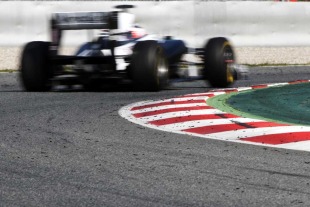- Tyre news
Pirelli will look into marbles

Pirelli is investigating ways to reduce the amount of marbles created by its tyres over a race distance.
The Italian tyre manufacturer returned to Formula One at the start of this year with the clear remit of increasing the amount of pit stops and making racing more exciting and unpredictable. To do so it developed a range of tyre compounds that degrade more quickly than the previous Bridgestone rubber.
Judging by the first two races the tyres appear to have the desired effect, but a side effect of the degradation is clumps of rubber, known as marbles, coming off the tyres. While nothing new to Formula One, the marbles from the Pirelli tyres tend to be larger and more prevalent during races. They have raised some concerns that driving off line becomes treacherous - Vitaly Petrov blamed his accident at Sepang on running onto the marbles - and that cars flick the rubber into the face of drivers behind.
"The faster tyre wear compared to previous years can lead to strips of rubber being deposited on the track, which vary in size but are generally the shape and consistency of toffees, weighing between 10 and 20 grams on average," explained a Pirelli press release. "These strips are pliable when warm but become more rigid when they cool down, just like toffee. These rubber 'marbles' have always existed in Formula One, but the characteristics of Pirelli's new compounds mean that the pieces are on average larger and softer than the hard and round 'marbles' that have been seen at grands prix in the past.
"A Formula One tyre, which weighs approximately eight and a half kilograms when new, will lose around a kilogram and a half as it wears over the course of a stint. With an increased number of pit stops, more rubber will be laid down on the track."
Pirelli's motorsport director Paul Hembery said his company would look in to reducing the amount of marbles, but not at the cost of exciting races.
"The rubber 'marbles' on the track are a natural consequence of the increased degradation that has led to more exciting races: all that rubber has to go somewhere, just as it has always done in the past," he said. "Having said that, we're here to serve the teams' best interests and we're looking at ways of reducing some of the deposits in the future. But that's not going to change our fundamental philosophy: we want to give racing back to the racers."

